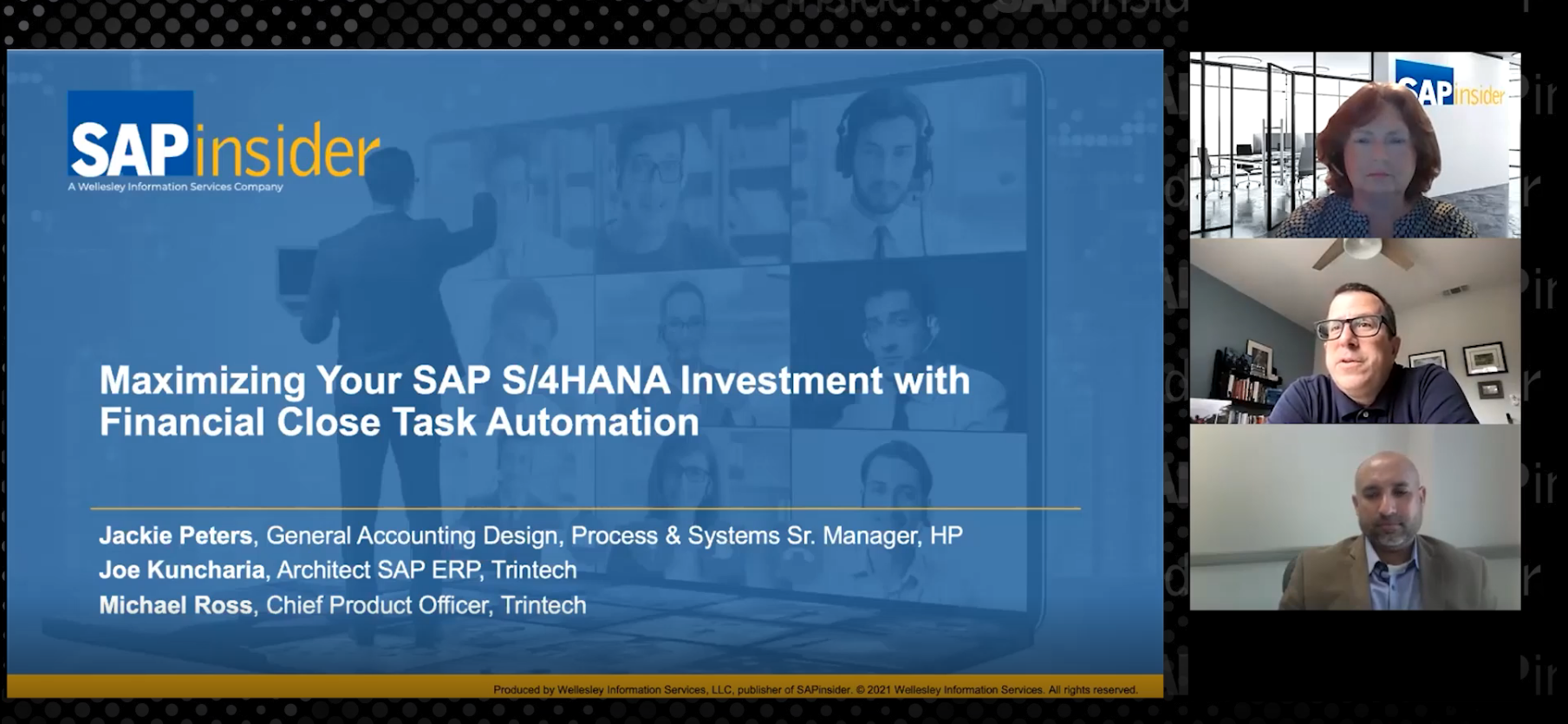Hershey’s Minimizes Management Adjustments to Financial Close
Finance Managers Leverage Central Finance and BlackLine to Improve Efficiency
by Pierce Owen, VP, Research & Publishing, SAPinsider
About 31% of the SAPinsider Community chose the “need to reduce time required to generate data and reporting at period close” as a key driver for their SAP S/4HANA Finance strategy, according to SAPinsider’s upcoming research on the “SAP S/4HANA Finance: State of the Market.” Additionally, 58% of the same survey’s respondents chose financial close as one of their top three pain points within the finance function. In Hershey’s case, the company improved the efficiency of its financial close by implementing SAP S/4HANA for central finance foundation and SAP Account Substantiation and Automation by BlackLine.
SAPinsider recently interviewed John Zimmerman, Director of Financial Data Systems at The Hershey Company. The American multinational chocolate manufacturer is headquartered in Hershey, Pennsylvania and has about 16,140 employees globally. This SAPinsider case study shares how Hershey’s has used Central Finance and BlackLine to consolidate its financial reporting environment.
Explore related questions
Preparation for SAP S/4HANA Required Reliable Reporting
Before implementing Central Finance and BlackLine, Hershey’s used a SharePoint site to control the balance sheet. “SharePoint couldn’t sustain 40 different company codes. That wasn’t manageable,” Zimmerman says.
Hershey’s started planning its migration to SAP S/4HANA in early 2016. “We went live with Central Finance in April 2018 as part of the path to manage our migration to SAP S/4HANA,” Zimmerman says.
Hershey’s must integrate and consolidate reporting data from two instances of SAP ERP and the three non-SAP ERP systems to perform its financial close each month. It gets real-time transaction details and monthly sub-ledgers from the SAP ERP instances in North America and Asia, a daily summary from the Brazilian subsidiary, and monthly trial balances from Amplify and ONE Brands’ ERP systems. All this data ends up in Central Finance and the BlackLine solution.
Central Finance essentially serves as an approach to prepare for and deploy SAP S/4HANA whereby a company replicates financial documents into the central system. This empowers the organization to harmonize master data and develop a common reporting structure even with data coming from distributed sources, both SAP and non-SAP.
“By the time we go live on SAP S/4HANA, we will have three years of information in Central Finance, which we see as part of our SAP S/4HANA pressure testing. We are evaluating if this is the right long-term structure, and it puts us in a good spot to make well-educated decisions about our SAP S/4HANA architecture now that we’ve seen Central Finance in action,” Zimmerman says.
Central Finance and BlackLine Consolidate and Track Close Activities
With Central Finance, Hershey’s can now easily pull together the overall summary picture of its finances and drill down to the transaction level for the information coming from the SAP ERP instances, including the ability to look at granular information down to sales orders without bouncing information from system to system.
“We stood up a reporting center of excellence in our shared services department, which started producing consistent operational reports for our manufacturing plants. Leveraging data from Central Finance, we can collect information on pounds of chocolate produced and the hours worked at each plant. This way, we know how many direct labor hours charged to a cost center that produces Hershey bars,” Zimmerman says.
Central Finance can also grab data from the integrated ERP systems at unnatural cutoff points so that SAP users no longer need to schedule jobs to snapshot data but can generate cutoffs and transition that information into different reporting dimensions. Capturing this information at will empowers the organization to make better, more timely decisions.
“We’re evaluating packaging spend by vendor based on our historical data in Central Finance. We could not easily reproduce this from SAP ERP alone. Without Central Finance, we would have to extract the data into other systems to conduct this analysis,” Zimmerman says.
To build visualizations of this type of data, Hershey’s has recently started evaluating Workiva. “Workiva does an excellent job of reporting and has an API connector to BlackLine to draw text level data and build visualizations,” Zimmerman says.
Hershey’s has implemented two major use cases for BlackLine so far: aging control and task management. It has a significant number of aged open items. BlackLine has a matching capability that highlights accountability to address and resolve these items in SAP ERP which will reduce the number of open items that will ultimately transition to SAP S/4HANA.
Task management in BlackLine keeps track of close activities in both Central Finance and SAP ERP. “We’re building user stories in financial areas by the tasks defined in BlackLine . This allows individuals to execute those tasks that they will own in SAP S/4HANA and reduces the risk of missing required activities,” Zimmerman says. This helps ensure that the right people and areas that will need to help deploy and run SAP S/4HANA test the same close steps they will complete in SAP S/4HANA.
“This also helps us maintain the business case for SAP S/4HANA,” Zimmerman says.
Hershey’s recently had to do a virtual close for the first time due to the COVID-19 crisis. BlackLine highlighted 1,500 tasks that employees needed to complete. “BlackLine was the anchor that got it done in time. We had daily calls with graphs and monitoring of task completion generated from BlackLine task management. Auditors had improved and remote visibility, and senior management got to the point where they were reviewing and signing-off on the critical high-risk items,” Zimmerman says.
With journal entries going into two instances of SAP ERP and three non-SAP ERP systems, managers used to have to wait forty-five minutes to see the entries reflected in the consolidated books. With Central Finance, this now takes seconds. Consolidating summarized information used to require digging deep into each separate system, but now, Hershey’s does all of this in Central Finance. “We are consistently closing in four and a half days with fewer management adjustments now,” Zimmerman says.
What Does This Mean for the SAPinsider Community?
Based on our research and the interview with John Zimmerman, the following considerations can help the SAPinsider Community better manage consolidated financial reporting:
- Assign task owners and proxies to finish high risk items. When going through task management in BlackLine , Hershey’s senior management reviewed and signed off on critical high-risk items. Large organizations need individual owners assigned to these types of critical closing tasks and have backups or proxies to pinch hit if necessary.
- Reconcile differences between custom and standardized coding blocks. Custom code in SAP ERP does not always translate well to SAP S/4HANA or Central Finance. Hershey’s had highly customized mass journal entries in its SAP ERP and had to reclassify its history with manual journal entries.
- If working with multiple instances of ERP, consider Central Finance to improve financial consolidation and prepare for SAP S/4HANA. Hershey’s legacy SharePoint solution could not handle the complexity of its business. It knew it needed to prepare for the eventual move to SAP S/4HANA and that it needed a more comprehensive solution in the meantime. SAP S/4HANA central finance foundation and BlackLine improved the efficiency of its financial close and furthered the business case for SAP S/4HANA.
- Involve key stakeholders in any financial consolidation project. Hershey’s has key stakeholders using BlackLine tasks and Central Finance now and has allowed them to contribute to the solution because these same people will help deploy and run SAP S/4HANA. A successful SAP S/4HANA project requires both user acceptance and continuous user education.
Pierce Owen, Vice President of Research & Publishing, SAPinsider, can be reached at Pierce.Owen@wispubs.com.





